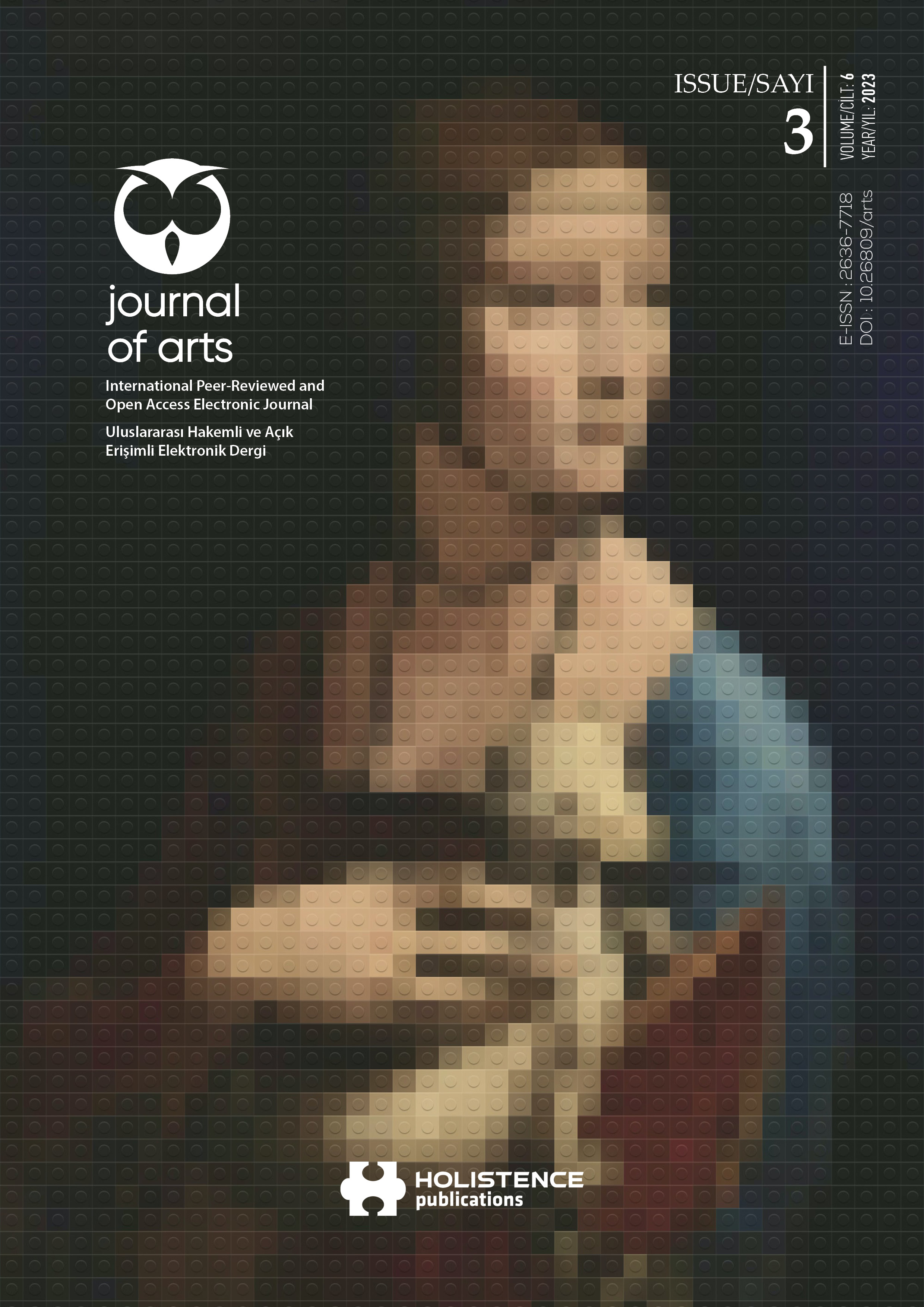Abstract
The breadth of the Kura Aras Culture’s spread area; The traces, architecture and preferred habitats of the Southern Caucasus, Northwest Iran, Eastern Anatolia, Amik Plain and the Levant were based on a migration movement by the researchers. This culture, which is defined by animal husbandry and an active lifestyle, also has regionally different terminologies. However, the most frequently encountered terminology; There was the Early Transcaucasian and Kura Aras Culture. This culture, which we do not know about their identities, what language they speak or why they prefer an active life, also contains many questions. Therefore, we can also consider this culture as a phenomenon. Despite this, when examining the Kura Aras Culture, the ceramics, which constitute the largest group of finds, provide us with information in terms of understanding the culture. It presents a very distinctive typology with its unique and characteristic ceramics of the culture, its distinctive construction technique and vessel profiles.
Ovçular Hill and Duzdağ are settlements in Nakhchivan but with two different functions. While Ovçular Hill is a Kura Aras camp settlement, Duzdağ has a functional importance in terms of economic and animal husbandry as it is a salt mine. When we examine the ceramics of the two settlements, we encounter ceramics with both similar and different characteristics. These differences, if we consider the topographic and functional characteristics of both settlements; clay, paste content, typology and surface treatments.
References
BAXŞELIYEV, V., MARRO C. & AŞUROV, S. (2010). Ovçular Tepesi (First Preliminary Report: the 2006-2008 Seasons). Baku-Elm,66.
BAXŞELIYEV, V., MARRO, C. & AŞUROV, S. (2011). Ovçular Tepesi (Second Preliminary Report: the 2009-2010 Seasons). Anatolia Antiqua XIX,66.
BELLİ, O. & SEVİN, V. (1999). Nahçıvan’da Arkeolojik Araştırmalar. Archaeological Survey in Nakhichevan. Arkeoloji ve Sanat Yayınları,ISBN: 9789756899409
GAİLHARD, N., BODE, M., BAKHSHALİYEV, V., HAUPTMANN, A. & MARRO, C. (2017). Archaeometallurgical investigations in Nakhchivan (Azerbaijan). What does the evidence from Late Chalcolithic Ovçular Tepesi tell us about the beginning of extractive metallurgy?. Journal of Field Archaeology 42/6, 20-50.
GÜLÇUR, S. & MARRO, C. (2012). The view from the north: comparative analysis of the Chalcolithic pottery assemblages from Norşuntepe and Ovçular Tepesi.VARİA ANATOLİCA XXVII,307-308.
HAMON, C. (2016). Salt mining from Duzdağı (Nakhchivan, Azerbaijan) in the 5th to 3rd millennium BC. Journal of field archaeology 41/4, 510-528.
HERRSCHER, E., POULMARC’H M., PALUMBİ, J., PAZ, G. S., ROVA, E., GOGOCHURİ, G., LONGFORD, G., JALABADZE, M., BİTADZE, L., VANİSHVİLİ, N., LE MORT, F., CHATAİGNER, C., BADALYAN R. & ANDRÉ, G (2021). Dietary practices, cultural and social identity in the Early Bronze Age southern Caucasus: The case of the Kura-Araxes culture.Paléorient.cilt 47.1,151-229.
IŞIKLI, M. (2005). Doğu Anadolu Erken Transkafkasya Kültürünün Karaz, Pulur ve Güzelova malzemesi Işığında Tekrar Değerlendirilmesi. Doktora Tezi, Ege Üniversitesi, İzmir.
IŞIKLI, M. (2011). Doğu Anadolu Erken Transkafkasya Kültürü Çok Bileşenli Gelişkin bir Kültürün Analizi. Arkeoloji ve Sanat Yayınları, İstanbul,41-42.
IŞIKLI, M. & ÖZTÜRK, G. (2019). Doğu Anadolu Kura–Aras Seramiği Üzerine. Seramik Araştırmaları Dergisi,18.
KİBAROĞLU, M. (2015). Archaeometric Investigations of Kura-Araxes Ware: A Review; Kura Aras Seramiğine Yönelik Arkeometrik Araştırmalar: Genel Bir Değerlendirme. Mehmet Işıklı, Birol Can (Ed.). ss.221-230. International Symposium on East Anatolia South Caucasus Cultures Proceedings I, Cambridge Scholars Publishing, Cambridge. ISBN: 1-4438-7810-3.
KİGURADZE, T. & SAGONA, A. G. (2003). On the Origins of the Kura-Araxes Cultural Complex. In Archaeology of the Borderlands: Investigations in Caucasia and Beyond, edited by A. T. Smith and K. Rubinson, 38-94.
LONGFORD, C. (2015). Plant Economy of the Kura-Araxes. A comparative analysis of agriculture in the Near East from the Chalcolithic to the Middle Bronze Age. Thesis submitted in fulfilment of the Degree of Doctor of Philosophy. Department of Archaeology. University of Sheffield, October,3.
MARRO, C. (2021). The functions of KuraAraxes ceramic containers in Caucasian early mining, MOM Éditions, Lyon, 79-100.
MARRO, C., BAKHSHALİYEV, V. & BERTHON, R. (2014). On the Genesis of the Kura Araxes Phenomenon : New Evidence from Nakhchıvan. Paleorient No: 40.2,141.
MARRO, C., BAKHSHALIYEV, V., SANZ, S. & ALIYEV, N. (2010). Archaeological Investigations on the Salt Mıne of Duzdağ (Nakhchıvan, Azerbaidjan). TÜBA -AR 13,230-233.
ÖKSE, T. (2002). Arkeolojik Çalışmalarda Seramik Değerlendirme Yöntemleri. Sanat Yayınları, İstanbul,Birinci Baskı,ISBN: 9786053963455
PALUMBİ, G. (2016). The Early Bronze Age of the Southern Caucasus. Gregory McMahon and Sharon R. Steadman (Ed.), Oxford Handbook Ancient Anatolia, Oxford University Press, Oxford, ISBN:0199336016
YALÇIN, Ü. Y., H. G. (2003). Zur Karaz Keramik von Tepecik.Mihriban Özbaşaran, Oğuz Tanındı, Ahmet Boratav (Ed.), Ostanatolien. Archaeological Essays in Honour of Homo amatus: Güven Arsebük İçin Armağan Yazılar, Ege Yayınları, İstanbul, ISBN: 9758070762
YAYLALI, S. (2008). Doğu Anadolu Erken Tunç Çağ Kültürü. Birol Can ve Mehmet Işıklı (Ed.). ss .567, Atatürk Üniversitesi 50. Kuruluş Yıldönümü Arkeoloji Bölümü Armağanı, Doğu’dan Yükselen Işık Arkeoloji Yazıları, Zero Prod. Ltd., İstanbul.ISBN 978 975 807 190 6
WİLKİNSON, T. (2015). Alternatif Ekonomiler: Yapısal-Sistematik Bakış Açısıyla Erken Transkafkasya Fenomeni. Mehmet Işıklı ve Birol Can (Ed.), Uluslararası Doğu Anadolu Güney Kafkasya Kültürleri Sempozyumu, Bildiriler I, Cambridge Scholars Publishing, Cambridge, ISBN: 1-4438-7810-3.
WİLKİNSON, T. (2014). The Early Transcaucasian Phenomenon in structural-systemic perspective: Cuisine, craft and economy. Paléorient 40.2, 203- 229.

This work is licensed under a Creative Commons Attribution 4.0 International License.
Copyright (c) 2023 Holistence Publications


